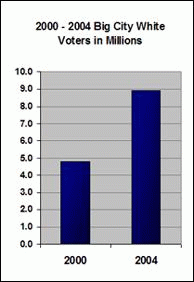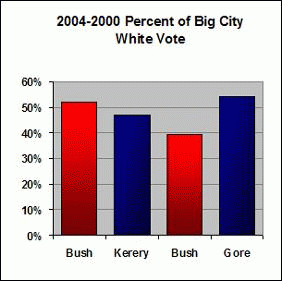The proximate cause would show up as big city activity focused on get out the vote (GOTV) efforts combined with advertising and major campaign events. Noticeable campaign efforts would have been essential. How could Bush make huge gains in admittedly hostile territory with out these efforts?
The general cause would have come in the form of a city-friendly charismatic Republican incumbent. We’d expect to see Bush in the cities laying on the charm, so to speak, and announcing a few high profile federal projects.
There is no apparent general cause for a shift in loyalties and voting in big cities. Unlike Ronald Reagan, who emphasized big city enterprise zones, Bush seemed indifferent to the needs of urban dwellers. Bush was not a city type of guy and rarely went to New York, Chicago, or Los Angeles for anything other than high level events. Not big on mixing with the masses, he demonstrated a clear preference for the solitary activity of clearing trees and brush from the Texas ranch he acquired just before the 2000 primaries. To the extent that 911 sensibilities may be considered, they seem to have been a far larger factor in the suburban than in the urban vote, at least as far as the exit polls indicate.
As for the proximate causes needed to turn opinion and attitude into an actual voting experience for the converted, they were certainly not evident. The Republican focus was always on ramping up the rural base and increasing the suburban vote. We found little if any comment in the Republican media machine about push polls, new programs for or special events in big cities to drive the vote. Bush gave speeches around the country, but you often needed a ticket to attend. Think back to any Bush big city rallies or events; rare and not a priority. Big city strategy was not a featured item in the 2004 Republican playbook.
How do we know this? To begin with, the core Democratic blocks in big cities didn’t change their votes according to the National Exit Polls. The NEP showed that black, Latino, and Jewish city voters went for Kerry at rates of 95%, 66%, and 80%.
The National Exit Poll gathers data each year on various campaign activities. The vital activity accompanying any significant vote increase is called GOTV - get out the vote. According to the NEP, only 1 in 10 urban residents contacted received Republican GOTV calls. Media buys in big cities were not even close to those in the suburbs where Bush only netted an extra 3% vote share over 2000, and campaign events for these urban groups were virtually non existent.
Scrutiny of the National Exit Poll was not the focus on election night. Hurried analysts looked at the vote totals coming in and offered explanations that we now know were not even remotely accurate. While we were told that this was a red-versus-blue election on November 7, it was also noted that Kerry’s GOTV strategy was working, based on increased votes/turnout. Senior analyst Charles Cook assumed that Bush made major inroads in black and Latino city voters but that assumption was not supported by the splits.
Then where did that Bush Urban Wave Originate?
There was a minimal Republican GOTV campaign in big cities and, in general, a minimal presence in the form of advertising and special events. Thus the basis for converting any shift in sympathy to Bush was lacking. Only the National Exit Poll, the revised edition the day after the election, had the special lens necessary to note surges of white big city voters who comprised the Bush victory margin. White voters had to account for the margin and the NEP analysts already knew that. There was no apparent general cause for a shift in loyalties and voting in big cities. The black, Latino, and Jewish voting blocks there had remained essentially unchanged since 2000.
For large urban areas, Latino votes doubled and went from 14% to 16% of the total vote compared to 2000. A small decline in absolute numbers, plus the increased Latino vote pushed the black urban share from 29% to 19% yet the national exit poll showed overall black turnout up 40%.
So the question remains: how do we account for the election winning Bush increases in big city vote share? We know that black, Latino, and Jewish voters in the big cities were strongly in favor of Kerry. The votes came from the only remaining big city voting block. There had to have been an unprecedented out pouring of white voters in large urban areas.
FIGURES 6 & 7. According to the NEP, white voters contributed less than 5 million votes to the big city segment in 2000 but almost 9 million in 2004. This is worthy of the term “surge.” They accounted almost exclusively for the increase from 2.3 million to 5.9 million big city votes for Bush from 2000 to 2004. Where did they come from? We may never know but they “won” the election.
The Nature of the Bush White Urban Wave
The white urban wave was shy, reluctant to show its true form and was perhaps a ghost in the machine. White turnout was supposed to go up as part of an overall increase. No one anticipated that it would materialize for Bush in the big cities in the way that it did. Nor does it help that these white voters were apparently “shy” about talking to pollsters.
Next Page 1 | 2 | 3 | 4 | 5 | 6 | 7 | 8 | 9 | 10 | 11
(Note: You can view every article as one long page if you sign up as an Advocate Member, or higher).







